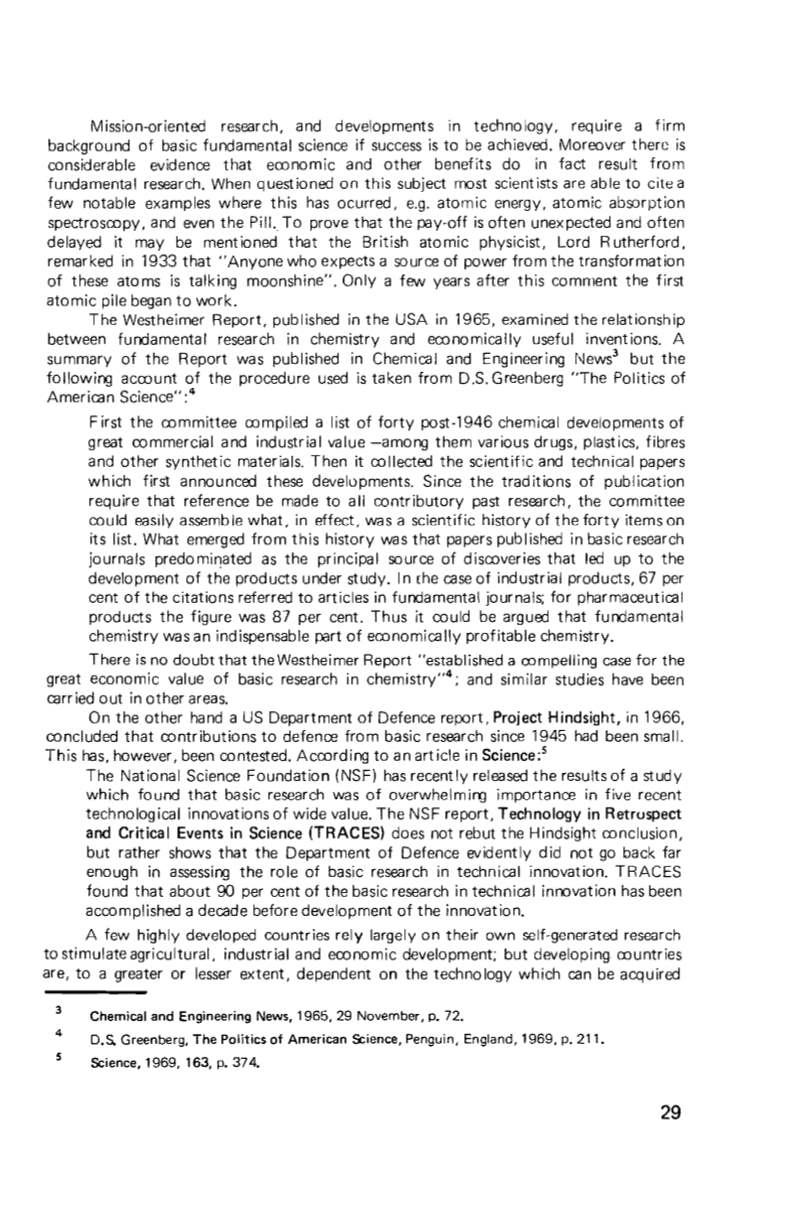
Mission-oriented research, and developments in technology, require a firm
background of basic fundamental science if success is to be achieved. Moreover therc is
considerable evidence that economic and other benefits do in fact result from
fundamental research. When questíoned on this subject most scientists are able to citea
few notable examples where this has ocurred, e.g. atomic energy, atomic absorption
spectroscopy, and even the Pil!.. To prove that the pay-off is often unexpeeted and often
delayed it may be ment ioned that the British ato míe physieist, Lord Rutherford,
remarked in 1933 that "Anyone who expects a source of power from the transformation
of these atoms is talking moonshine".Only a few years after thís comment the first
atomic pile began to work.
The Westheimer Report, published in the USA in 1965, examined the relationship
between fundamental research in chemistry and economically useful inventions. A
summary of the Report was published in Chemical and Engineering r..Jews
3
but the
fOllowing account of tlle procedure used is taken from D.S. Greenberg "The Politics of
American Science,,:4
First the committee compiled a list of forty post-1946 ehemical developments of
great commercial and industrial value -among them various drugs, plastics, fibres
and other synthetic materials. Then it collected the scientific and technical papers
which first announced these develúpments. Sinee the traditions of publication
require that reference be made to all contributory past researeh, the committee
could easily assemble what, in effeet, was a scientific history of the forty items on
its list. What emerged from this history was that papers published in basic research
journals predominated as the principal source of discoveries that led up to the
development of the products under study. In [he case of industrial produets, 67 per
cent of the eitations referred to articles in fundamental journals; for pharmaceutical
products the figure was 87 per eent. Thus it could be argued that fundamental
chemistry was an indispensable part of economically profitable chemistry.
There is no doubt that theWestheimer Report "established a compelling case for the
great economic value of basie research in chemistry"4; and similar studies have been
carried out in other areas.
On the other hand a US Department of Defence report, Project Hindsight, in 1966,
concluded that contributions to defence from basie research since 1945 had been small.
This has, however, been contested. According to an art iele in Science;5
The National Science Foundation (NSF) has recently released the resultsof a study
which found that basic research was of overwhelming importance in five recent
technological innovations of wide value. The NSF report, Technology in Retruspect
and Critica I Events in Science (TRACES) does not rebut the Hindsight conclusion,
but rather shows that the Department of Defence evidently did not go back far
enough in assessing the role of basic research in technical innovation. TRACES
found that about 90 per cent of the basic research in technical innovation has been
accomplished a decade before development of the innovation.
A few highly developed countries rely largely on their own self-generated research
to stimulate agricultural, industrial and economic development; but developing countries
are, to a greater or lesser extent, dependent on the technology which can be acquired
3
4
Chemical and Engineering News, 1965, 29 November, P. 72.
D.S. Greenberg, The Politics of American S::ience, Penguin, England, 1969, p. 211.
Science,1969, 163, p. 374.
29


